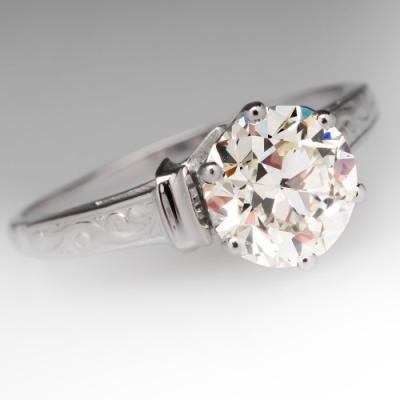
Posted in: Jewelry History
 The story of diamond cuts is a fascinating look at the evolution of industry. In previous posts, we've explored a history of early cuts, as well as the primary characteristics of a number of these early cuts.
The story of diamond cuts is a fascinating look at the evolution of industry. In previous posts, we've explored a history of early cuts, as well as the primary characteristics of a number of these early cuts.
 At this point in the timeline, it's time to take a look at the history of transitional cut diamonds. These diamonds are unique in that they fall outside the parameters of the Old Mine and Old European cuts of the 1800s. Similarly, they do not quite measure up to today's standard Modern Round Brilliant.
Transitional-cut diamonds typically bridge the gap between antique and vintage. Direct descendants of the Old European Cut, these progressive cuts saw an evolution toward a larger table, a lower crown, and a smaller culet than previous cuts. However, unlike later brilliants, the girdles of these stones remained unfaceted.
These cuts were the invention of those cutters under the watchful eye of Henry D. Morse. Mr. Morse owned the first American diamond cutting operation. His passion for diamonds led to the first cuts specifically designed to unlock the beauty of these stones. For this reason, many refer to Transition Cuts as Early American Cuts.
These cuts, also sometimes called Early Modern Cuts, are considered precursors to both the Modern Round Brilliant and the Ideal cuts. Using the newly-invented steam-powered diamond lathe, Mr. Morse and his team sought to standardize proportions for cutting diamonds. Mr. Morse was a true pioneer, and as such these transition diamonds feature a wide range of proportions, angles, and facet numbers. Since they were hand faceted without uniform parameters, these stones are truly one-of-a-kind.
At this point in the timeline, it's time to take a look at the history of transitional cut diamonds. These diamonds are unique in that they fall outside the parameters of the Old Mine and Old European cuts of the 1800s. Similarly, they do not quite measure up to today's standard Modern Round Brilliant.
Transitional-cut diamonds typically bridge the gap between antique and vintage. Direct descendants of the Old European Cut, these progressive cuts saw an evolution toward a larger table, a lower crown, and a smaller culet than previous cuts. However, unlike later brilliants, the girdles of these stones remained unfaceted.
These cuts were the invention of those cutters under the watchful eye of Henry D. Morse. Mr. Morse owned the first American diamond cutting operation. His passion for diamonds led to the first cuts specifically designed to unlock the beauty of these stones. For this reason, many refer to Transition Cuts as Early American Cuts.
These cuts, also sometimes called Early Modern Cuts, are considered precursors to both the Modern Round Brilliant and the Ideal cuts. Using the newly-invented steam-powered diamond lathe, Mr. Morse and his team sought to standardize proportions for cutting diamonds. Mr. Morse was a true pioneer, and as such these transition diamonds feature a wide range of proportions, angles, and facet numbers. Since they were hand faceted without uniform parameters, these stones are truly one-of-a-kind.
 One could call this transition the trial-and-error phase, for that is essentially what these diamonds represent. While symmetry and consistency were the goals, it would take some time for the cutters to work out all the angles. Ultimately, it would be another 30 or 40 years before the work represented by Mr. Morse and his men would be adopted into mainstream use, thanks in large part to the mathematical analysis of Marcel Tolkowsky.
As is often the case, these practice cuts are now a significant piece of diamond-cutting history. Transitional diamonds are special, and we celebrate whenever we find a fine specimen from such an important time in jewelry history. Currently, we have a number of gorgeous engagement rings featuring transitional cut diamonds. We invite you to browse our selection. Don't forget to make an appointment to view these remarkable pieces in person.
One could call this transition the trial-and-error phase, for that is essentially what these diamonds represent. While symmetry and consistency were the goals, it would take some time for the cutters to work out all the angles. Ultimately, it would be another 30 or 40 years before the work represented by Mr. Morse and his men would be adopted into mainstream use, thanks in large part to the mathematical analysis of Marcel Tolkowsky.
As is often the case, these practice cuts are now a significant piece of diamond-cutting history. Transitional diamonds are special, and we celebrate whenever we find a fine specimen from such an important time in jewelry history. Currently, we have a number of gorgeous engagement rings featuring transitional cut diamonds. We invite you to browse our selection. Don't forget to make an appointment to view these remarkable pieces in person. 10 years ago
39 view(s) 